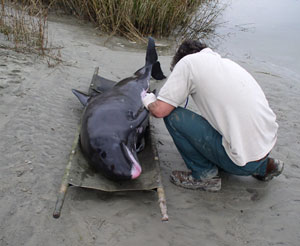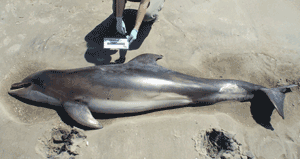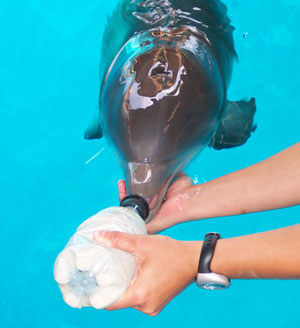
When a marine mammal is found on shore or in water too shallow for it to survive, it is termed a "stranding". Some individuals strand by themselves or in groups (called a mass stranding). Mass strandings can involve a few to a few thousand animals in a single event. On some occasions, stranded animals are still alive can be returned to sea once they have been examined. However, some animals are dead, sick, or dying when they are found. Some cetaceans, like killer whales, will purposefully chase prey up onto land or into very shallow water. They then strand themselves to capture their prey and flop their way back into the water.

Strandings of live animals can be caused because an animal (or a member of a group) is sick, disorientated or for other unknown reasons. Stranded animals are sometimes species that are outside of their normal range and are experiencing conditions that are not normal for them, like water temperatures that are too cold or too warm, or they are in areas that don’t have enough or the appropriate kind of food. Some sick marine mammals may purposefully strand themselves and even if they are returned to the sea will strand again. Sick animals may try to keep itself near the water surface so that it can breathe, propping itself on land when it can’t swim or keep itself afloat. As the tide changes this animal can become stranding above the water line. Animals that die of old age, disease, parasites, ship collisions, and entanglement while out at sea can also become stranded as winds or waves push them toward coastal areas.
Mass strandings, when many animals strand in groups, are a mystery. In some mass strandings, there is no apparent injury or illness in any stranded individual. In some cases, the highly social characters of many cetaceans may be the cause of mass strandings. If a single individual gets sick or is dying and it strands, members of its school may also follow it. If healthy individuals are rescued, they sometimes will return to the injured, stranded individual because of the closeness between individuals in the group.

Some human activities may be the cause of strandings in some cases. Military sonar has been suggested as a direct cause of strandings in beaked whale species. These species are deep divers and it is suggested that sonar disrupts their dives causing death from decompression sickness. (Click this link for more information about Noise Pollution). Additionally, dead or dying marine mammals that have been stranded have illnesses caused by human activities. These include animals that apparently died of starvation or internal injuries caused by eating plastic debris or commercial fishing gear or becoming entangled in commercial fishing gear. (Click this link for more information about Pollution). One sperm whale, Physeter macrocephalus, stranded on the west coast of the United States had a piece of commercial fishing net that was over 172 square feet (16 square meters) in size (larger than the area covered by two queen-sized mattresses). This and another individual stranded in the same year were both believed to have died from problems resulting from eating netting and plastic debris near the ocean's surface.
What to do when you find a stranded animal?
If you see any stranded marine mammal on the coast of Georgia, you should notify your state’s Stranding Network contact. Take careful note of the animal’s location and leave detailed information along with a name and phone number where you can be reached. All regions in the United States and many countries have Marine Mammal Stranding Programs. Since marine mammals are protected in the United States and most countries, notifying some person of authority is the best way to ensure that the animal is quickly assisted with minimal harm.

Some seals may use land to recover from an illness or to avoid ocean predators. Encountering one on the coast may not represent a stranding. However, there are no seals that normally occur on the coast of Georgia and if one is found the Stranding Network contact should be notified of its location.
Until help can arrive, be careful of the animal's tail and head. Wild animals can be dangerous. Do not try to get the animal back into the water. These animals are commonly sick or injured and would need treatment before they can successfully return to sea. If the animal is alive, stay with the animal and try to keep them wet. Using wet towels or splashing water over the animal will help prevent them from getting dry. Make sure their blowholes are not covered or splashed with water; this is what they use to breathe. Try to keep crowds or people away from the animal, because this can cause more stress and harm to them.
Remember that the Marine Mammal Protection Act protects marine mammals from harm, or taking any parts of dead animals.
Contacts:
National
NMFS National Enforcement Hotline for Violations: 1-800-853-1964
Regional
Southeast Region Marine Mammal Stranding Network (including Puerto Rico and U.S. Virgin Islands)
NMFS Southeast Marine Mammal Stranding Hotline: 877-433-8299
Georgia
Georgia Marine Mammal Stranding Hotline: 1-800-241-4113 / 912-269-7587
Georgia Sea Turtle Stranding and Salvage Network Contact: 912-280-6892
NOAA Network Representative
Wayne McFee
NOAA/NOS/CCEHBR
219 Ft. Johnson Rd.
Charleston, SC 29412
843-762-8592
Fax: 843-762-8700
wayne.mcfee[at]noaa.gov
State Coordinator
Clay George
GA DNR
One Conservation Way
Brunswick, GA 31520
1-800 2 SAVE ME (1-800-272-8363)
Fax: 912-262-3143
clay_george[at]dnr.state.ga.us
Florida Florida Marine Mammal Stranding Hotline: 888-404-FWCC (3922) Florida Sea Turtle Stranding and Salvage Network Contact: 904-573-3930
South Carolina South Carolina Marine Mammal Stranding Hotline: 800-922-5431 South Carolina Sea Turtle Stranding and Salvage Network Contact: 843-953-9016
What do researchers do with a stranded animal?
Much of the information what we know about cetaceans today comes from research of stranded individuals. By measuring and releasing live individuals we can learn some about their sizes, weights, and about potential threats. Some rescued individuals can also be fitted with a tracking device so that researchers can learn more about its movements and behavior after it has been moved back out to sea. By examining dead individuals, we can learn about how large they get, what their internal organs look like, what they eat, and what might have caused their deaths. Sadly, mass strandings provide even more information about marine mammals, like what species school together, ratios of males and females in a school and variation in sizes and ages.
References:
Balcomb, K.C. III and D.E. Claridge. 2001. A mass stranding of cetaceans caused by naval sonar in the Bahamas. Bahamas Journal of Science 8: 2-12.Perrin W.F., B. Würsig, and J.G.M. Thewissen, eds. 2009. Encyclopedia of Marine Mammals. Academic Press, Amsterdam, p. 1316.
Weilgart, L.S. 2007. The impacts of anthropogenic ocean noise on cetaceans and implications for management. Canadian Journal of Zoology 85: 1091-1116.

 Marine Mammals of Georgia
Marine Mammals of Georgia